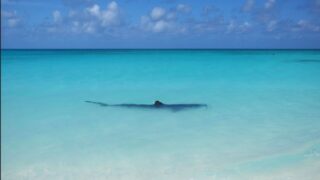The state of Hawaii reported Monday night that shark warning signs are now up on Maui from Hookipa Beach Park to Baldwin Beach Park. That occurred following what the state called “an apparent encounter with a shark” that took place at Tavares Bay, not far from Mama’s Fish House. A 45-year-old Maui woman sustained minor injuries at around 1:00 p.m. Monday in a shark encounter, not with a tiger shark, but rather with a Galapagos shark.
First responder resources were summoned from 1) The Maui Fire Department Ocean Safety Division, 2) Maui Police, and 3) Hawai`i DLNR (Department of Land and Natural Resources) Division of Conservation and Resources Enforcement (DOCARE).
The agencies “worked together to place warning signs. Under established protocols, beaches one mile on either side of Tavares Bay where the incident occurred, are under warning until noon tomorrow. At that time, if there are no signs of shark presence, the signs will be removed, and people can go back into the water.” Or if needed, additional warning signs will remain.
The woman injured in the Maui shark attack reported the following.
She told authorities “that while she was surfing, a shark she described as a 10-12-foot-long Galapagos shark bit her board and launched her into the air. She landed on the shark, which then bit through her board leash. She was able to get back onto her board and swim to shore without further incident.” The laceration injuries as a result of the shark bite are reported to be minor although it was indeed a very scary thing.
The incident was reported to have occurred in 3 to 4 feet of water above the ocean floor but with “limited clarity due to high surf.” Authorities are returning to the area in the morning to look for any signs of the shark.
Galapagos sharks.
The Galapagos shark is found worldwide and prefers clear reef environments around islands such as Hawaii. It is not unusual for them to reach 10′ or more. They can be identified by their tall first dorsal fin, which features a rounded tip.
The Galapagos is an “active predator.” It primarily feeds bottom-dwelling fish, although larger sharks can have a varied diet, including other sharks, in addition to various sealife and reportedly even garbage.
Galapagos shark image in Hawaii courtesy of NOAA.
Get Breaking Hawaii Travel News







Nothing says aloha like a shark attack. I guess it is a polite way to just say the beaches are closed. Go shopping.spend money but don’t go in the water. Lightning hitting a plane. These stories just make it seem like the tourist is warned to stay away.
I’d be interested to know how she knew it was a Galapagos shark. To most people a shark is a shark. Though some type are pretty obvious when you see them. Not so the Galapagos.